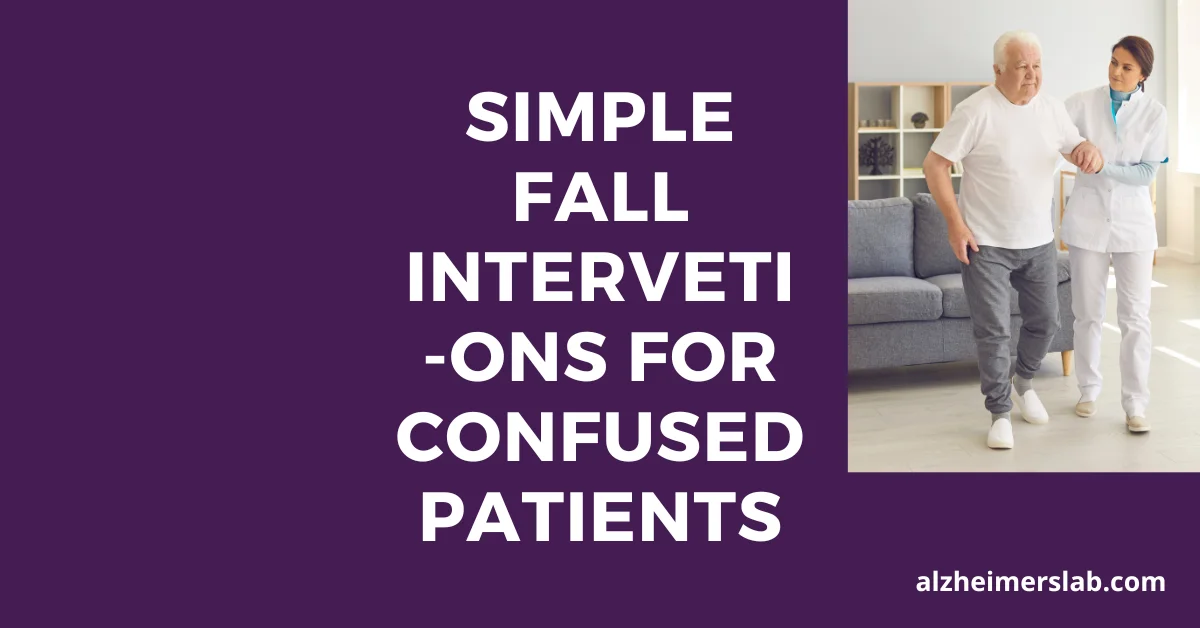Simple Fall Interventions for Confused Patients
Picture this: we’re all getting older, and sometimes age brings along some memory lapses or mobility issues. It could be your grandparent, your parent, your neighbor, or even you someday. When someone we care about becomes prone to falls due to confusion, it can be a worrisome situation. But guess what? There are simple and effective ways to help prevent these falls and ensure safety. In this discussion, we’ll explore some standard interventions that can make a significant difference in preventing falls for confused patients.
Identifying the Red Flags

First things first, let’s talk about identifying the red flags. If you or someone you know is dealing with confusion or unsteadiness, it’s crucial to recognize these warning signs. Here are a few common ones:
Memory Lapses: Frequent forgetfulness, such as not remembering where they are or why they went into a room.
Difficulty Walking: Unsteady gait or trouble maintaining balance, which can lead to stumbling.
Medication Side Effects: Some medications can cause dizziness or confusion. Keep an eye out for these effects.
Vision Problems: Poor eyesight can make it hard to navigate surroundings, leading to potential falls.
Cluttered Spaces: A messy or cluttered home can increase the risk of tripping and falling.
Simple Home Modifications

Now that we know what to look out for, let’s dive into some simple home modifications that can make a world of difference:
Proper Lighting: Good lighting is your best friend. Ensure that your home is well-lit, especially in hallways, staircases, and bathrooms. Motion-sensor lights can be a handy addition to prevent fumbling for switches in the dark.
Contrasting Colors: Consider using contrasting colors for furniture and floors. For instance, a dark-colored chair on a light-colored floor is easier to see, making it less likely to be accidentally tripped over.
Grab Hold: Encourage your loved ones to hold onto something sturdy when they move around the house. Whether it’s the edge of a table or the back of a couch, having support within arm’s reach can prevent falls.
Safety Rails: Install safety rails where needed. Stair rails, bath rails, and toilet rails provide crucial support. Avoid using towel bars for support; they’re not designed to hold weight.
Clear Pathways: Keep pathways clear of obstacles. This simple step can make a significant difference in preventing tripping and falling.
Using the Red Flag System

Now, let’s talk about an easy-to-implement system that can help prevent falls in confused patients:
Imagine you’re in a hospital, and you see a nurse wearing a red arm band or notice a red star on a board by a patient’s name. What does that mean? It means that person is at a high risk of falling. This red flag system helps healthcare providers stay vigilant and take extra precautions. But guess what? We can use a similar system at home, too!
Red Dot on the Door: Consider placing a red dot on the outside of the bedroom or bathroom door of the person at risk. This serves as a visual reminder for everyone to be extra careful when that door is in use.
Stay Close While Toileting: When the person needs to use the bathroom, stay with them. This way, you can provide support and prevent falls, especially during those nighttime trips to the bathroom.
No Lights Out at Night: For added safety, don’t turn off the lights at night. Nightlights can be a great solution, ensuring there’s always some illumination to prevent disorientation.
Assist with Sitting and Personal Hygiene: When helping the person sit up or assist with personal hygiene, take your time and ensure they are stable before letting go. A moment of patience can prevent hours of discomfort or a trip to the hospital.
The Importance of Communication

Now, let’s talk about something we all can do better – communication. Open and clear communication is vital in preventing falls:
Talk About Medications: If your loved one is taking medications, discuss any side effects with their healthcare provider. Sometimes, a simple medication adjustment can reduce dizziness and confusion.
Regular Check-Ins: Make it a habit to regularly check in with your loved one. Ask how they’re feeling and if they’ve experienced any slips or falls. Open dialogue can help identify problems early.
Doctor’s Visits: Don’t skip those doctor’s appointments. Regular check-ups can help catch and address any health issues that might contribute to falls.
Emergency Plan: Have a plan in place in case of a fall. Know whom to call and what steps to take. Being prepared can make a stressful situation more manageable.
Providing Support and Encouragement

Lastly, let’s talk about providing support and encouragement. Sometimes, a little bit of emotional support can go a long way in fall prevention:
Empathy: Put yourself in their shoes. Understand that dealing with confusion and the fear of falling can be scary. Show empathy and patience.
Encourage Movement: Encourage gentle exercises or activities that improve balance and strength. This can boost confidence and reduce the risk of falls.
Be a Buddy: Offer to be their walking buddy. Whether it’s a stroll around the yard or a trip to the grocery store, having a companion can provide extra stability.
Celebrate Small Wins: Celebrate the small victories. Did they navigate the hallway without stumbling? That’s fantastic! Acknowledging these successes can boost morale.
Conclusion
Safety is a top priority, especially when it comes to our loved ones who might be confused or unsteady on their feet. By identifying red flags, making simple home modifications, using the red flag system, fostering open communication, and providing support and encouragement, we can significantly reduce the risk of falls.
Now, here’s a question for you: What other strategies have you found effective in preventing falls for confused patients? Your experiences and insights could be invaluable to others in our community. Please share your thoughts in the comments section below.

